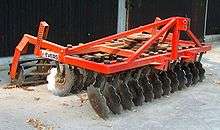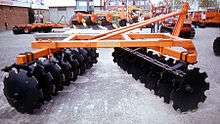Disc harrow



A disc harrow is a farm implement that is used to till the soil where crops are to be planted. It is also used to chop up unwanted weeds or crop remainders. It consists of many carbon steel and sometimes the longer-lasting boron discs, which have many varying concavities and disc blade sizes and spacing (the choices of the later being determined by the final result required in a given soil type) and which are arranged into two sections ("offset disc harrow") or four sections ("tandem disc harrow"). When viewed from above, the four sections would appear to form an "X" which has been flattened to be wider than it is tall. The discs are also offset so that they are not parallel with the overall direction of the implement. This arrangement ensures that the discs will repeatedly slice any ground to which they are applied, in order to optimize the result. The concavity of the discs as well as their offset angle causes them to loosen and lift the soil that they cut.
A discer is an evolved form of a disc harrow, more suitable to Saskatchewan prairies, where it was developed in the 1940s. It does not leave ridging and it is lighter to pull, so it can be made bigger. After the 1980s their domination started to fade.[1]
Name variations
In various regions of the United States, farmers call these implements just discs (or disks), and they reserve the word harrow for the lighter types of harrow, such as chain and tooth harrows. Therefore, in these regions, the phrase "plowing, disking, and harrowing" refers to three separate tillage steps. This is not any official distinction but is how farmers tend to speak.
It is also common, at least in the United States, to consider disc plows to be a separate class of implement from discs (disc harrows). The first is a true plow, which does primary tillage and leaves behind a rough surface, whereas the second is a secondary tillage tool.
History
Before invention of the modern tractor, disc harrows typically consisted of two sections, which were horse-drawn and had no hydraulic power. These harrows were often adjustable so that the discs could be changed from their offset position. Straightening the discs allowed for transport without ripping up the ground; also, they were not as difficult to pull. Overuse of disc harrows in the High Plains of the United States in the early 20th century may have contributed to the "Dust Bowl".
Today
Modern disc harrows are tractor-driven and are raised either by a three-point lift or hydraulically by wheels. Some large ones even have side sections that can be raised vertically or that fold up to allow easier road transport or to provide better storage configurations.
Uses
Primary heavy duty disc harrows of 265 to 1000 lbs per disc are mainly used to break up virgin land, to chop material/residue, and to incorporate it into the top soil. Lighter secondary disc harrows help completely incorporate residue left by a primary disc harrow, eliminate clumps, and loosen the remaining packed soil. The notched disc blades chop up stover left from a previous crops, such as cornstalks. Disc harrows incorporate remaining residue into the top soil, promoting rapid the decay of the dead plant material. Applying fertilizer onto residue on the surface of the soil results in much of the applied nitrogen being tied up by residual plant material; therefore it is not available to germinating seeds. Disc harrows are also generally used prior to plowing in order to make the land easier to manage and work after plowing. Applying a disc harrow before plowing can also reduce clogging and allow more complete turning of the soil during plowing.
A disc harrow is the preferred method of incorporating both agricultural lime (either dolomitic or calcitic lime) and agricultural gypsum, and disc harrowing achieves a 50/50 mix with the soil when set correctly, thereby reducing acid saturation in the top soil and so promoting strong, healthy root development. Lime does not move in the soil, and this poses a critical challenge to sustainable zero-till farming, especially considering that chemical fertilizers are generally used by farmers around the world.
Offset Disc Harrow
The heavy duty disc with large diameter disc blades of 26", 28", 30", 32", 36", and 40", and with increased disc spacings of 10", 14", and 18" are the primary tillage tools that are used to break virgin ground, to incorporate residue into the soil in preparation for a ripper / subsoiler, and to break up a compacted soil in order to increase soil aeration and to promote soil permeability in lower levels of the soil profile. Prior to a planting operation, a secondary disc harrow with narrow disc spacing of 8", 9", and even 10" with disc sizes ranging from 20", 22", 24", to 26" can be used. Other similar secondary tillage tine implements or rotary harrows are also widely used. When choosing secondary tillage equipment, soil type as well as soil moisture content at the time must be considered. Lighter secondary disc harrows are primarily used to break down soil clods into smaller pieces. By so doing, water penetrates more easily into the soil, soil aeration is increased, and the activity of soil biota is enhanced; the final result is a seed bed that is suitable for planting.
See also
References
- ↑ A New Machine, Ruth Bitner, Western Development Museum, Canada, October 2012.
External links
![]() Media related to Disk harrows at Wikimedia Commons
Media related to Disk harrows at Wikimedia Commons